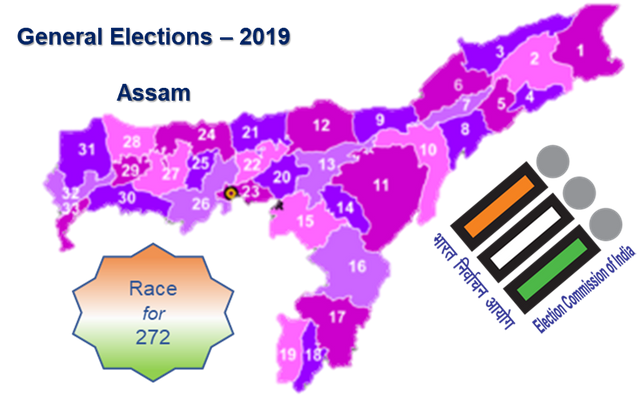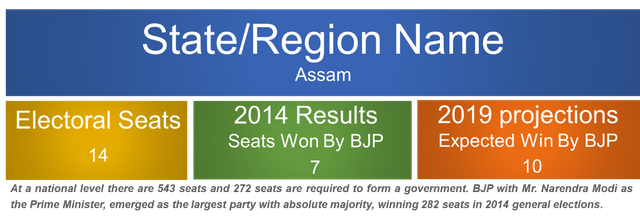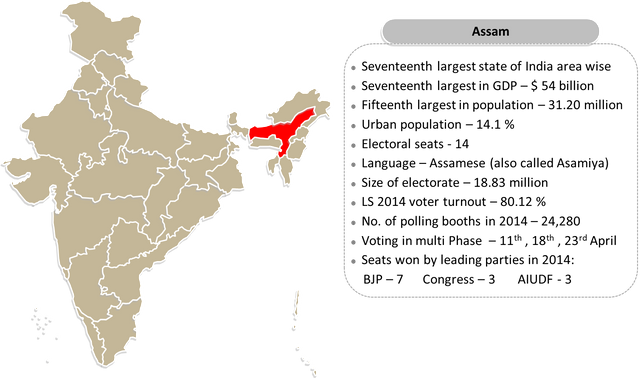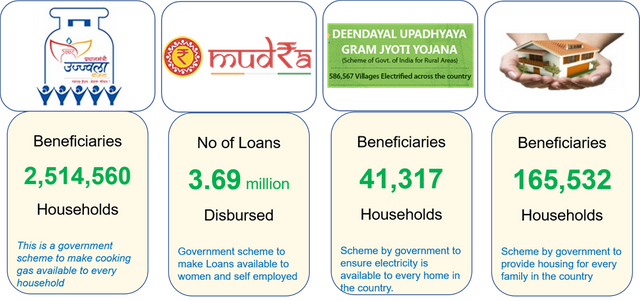India Election Analysis and Forecast – Part 5: Assam

In this article, the election dynamics for the state of Assam is discussed and analyzed.

The state of Assam is the largest state of in northeast India. Ever since 1947, the state has virtually been ruled by a Congress government. It is almost 73 years barring ten years in between – from 1985 to 90, and, 1996 to 2001. During these two terms, it was ruled by one of the regional parties with strong local identity – Asom Gana Parishad. The geographical location of the state and the economic and electoral data for the state is given in the following picture.

Assam state went into a turmoil in the year 1979. The reason for agitation was the infiltration of the state by foreigners in the aftermath of the 1971 India Pakistan war when East Pakistan was separated and became an independent nation called Bangladesh on the eastern border of India. The local Assamese population felt threatened of being run over by the sheer numbers of people infiltrating from Bangladesh who were Bengali speaking Muslims. The agitation started with student protests but quickly snowballed into a full-blown movement. Though starting as a peaceful movement, things went on to become violent. In the midst of agitation and movement, the central government took a decision to grant voting rights to illegal immigrants numbering about 4 million. This was the final straw and lead to an extremely violent reaction by the local population. Almost like ethnic cleansing. The Nellie massacre in February 1983 as it is known resulted in a very large number of people losing their lives. For the first time since 1947, the Congress party was booted out in 1985 assembly elections and the popular local party Asom Gana Parishad came to power. The new ruling dispensation in Assam signed an agreement with the central government to bring about peace to the state. This was known as the ‘Assam Accord’ and under it the key issue an understanding who would be classified as ‘illegal immigrant’. According to the agreement the cut off date was kept at 1971.
However, the accord never got implemented sincerely. Even today illegal immigration across the border takes place. Since 2014 there has been some check. The situation further improved with the streamlining of the boundary between India and Bangladesh. India and Bangladesh signed a border agreement in May 2015. However, it is well known that damage to a great extent had already been done on the demographic front. As per 2011 census, the Muslim population in Assam had risen to a level where it constitutes almost 34% of State’s population.
Winds of change were visible when BJP for the first time won 7 parliamentary seats out of 14 in 2014. And, in the assembly elections thereafter in 2016 BJP won almost 70% of the assembly seats – 86 seats out of 126 thus coming into power in Assam for the first time ever. BJP kept the foreigner issue on a back burner but reinforced border checks to prevent any illegal crossing. The party, on the other hand, embarked upon a journey to unleash the full development potential of the state. The following data gives how the people of the state benefited from the scheme.

BJP also started investing heavily in infrastructure projects that not only benefit Assam but also benefit the entire North East India. This included building bridges, airports and road networks. The BJP also commissioned inland waterways on Brahmaputra river the main river running across North East India. Read section C – North East Development Scheme - for understanding the details of Infrastructure projects undertaken by BJP in Northeast. ( https://steemit.com/india/@ajain/ft-rebuttal-part-2-assessing-failed-infrastructure-overhaul ).
All this augured very well for BJP. There was a tremendous appreciation for the good governance by the party. However, things went somewhat awry when BJP decided to go ahead and implement the Assam Accord which had been in sort of abeyance all these years. More specifically the National Register of Citizens (NRC) to identify and subsequently deport illegal immigrants. The final draft of NRC was released in July 2018 and as expected it ran into heavy weather. There were primarily two reasons. First the Errors of Omission. This was serious but was not very difficult to handle. The government announced a proper process to accept representations by people claiming to be genuine citizens of the country and make sure their claims are verified diligently. The government also assured that no genuine citizen will be left out. The problem, however, was on the second one. After identifying the illegal immigrants, what happens. Here all sorts of politics were let loose. Almost 95% plus, or perhaps even 99% plus illegal immigrants were expected to be Muslims. Needless to mention that these are the vote banks of the so-called secular parties of India who blatantly indulge in Muslim appeasement for votes. All these parties – Trinamool Congress (TMC), Indian National Congress (INC), All India United Democratic Front (AIUDF) – were up in arms against the decision. As of today, the process of hearing the cases of missing names is going on so there is the lull before the storm. The NRC has an impact not just in the state of Assam but also in the state of West Bengal.
While all this was happening, yet another salvo was fired by the BJP central government. This was in the nature of Citizenship Amendment Bill (CAB). This bill aimed to provide citizenship to those people from neighboring countries (Afghanistan, Pakistan and Bangladesh) who had been forced to seek shelter in India because of religious persecution or fear of persecution in their home countries. Needless to mention that these people were predominantly Hindus, Sikhs, Jains, Buddhists, Parsis, and Christians. The opposition to this bill was on two counts. First, the fear of locals that their ethnic identity will get lost over time. And second, why should Assam bear the brunt of this resettlement. Both these points have been tackled by the government. As of today, the bill was referred to a Joint Parliamentary Commission. However, with fresh elections taking place now it can be termed to be in sort of abeyance at the moment. But it remains to be on the agenda of BJP and figures in their promise.
If you combine NRC and CAB, it effectively means that from among the people identified as illegal immigrants, there could be a pathway for citizenship for Hindus, Sikhs, Jains, Buddhists, Parsis, and Christians. BJP is confident that the local population will buy into it to keep the Muslim influence under check. Of course the issue of preserving local heritage, culture and identity will need to be addressed. BJP is very confident of managing and overcoming the resistance of the local population. The jury is out. Elections will be the testing ground.
In the assessment of the authors, BJP is on a winning wicket in Assam. They have a positive sentiment due to the great work done by them in terms of various government schemes and infrastructure projects. The authors also feel that BJP has been able to assure people of the NRC and CAB being in their ultimate interest and have also been able to win them on the assurance to preserve their local heritage, culture, and identity. The assessment is that BJP will win 10 out of 14 seats in Assam.
Given below is the summary of running total of the BJP expected win so far with this article included.

A reminder
If you have liked the article do upvote us. Please also feel free to comment on the article. We welcome relevant discussions and opinions.